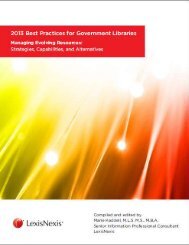2012 Best Practices for Government Libraries
2012 Best Practices for Government Libraries
2012 Best Practices for Government Libraries
Create successful ePaper yourself
Turn your PDF publications into a flip-book with our unique Google optimized e-Paper software.
178<br />
BEST PRACTICES <strong>2012</strong><br />
Planning <strong>for</strong> the Worst: Disaster Preparedness and Response in<br />
Federal <strong>Libraries</strong><br />
By Aileen M. J. Marshall, MA, MLIS, Reference Librarian at the U.S. Department of<br />
Transportation<br />
I don't think I exaggerate by saying that we all remember the magnitude 5.8<br />
earthquake on August 23rd, 2011, and the predicted hurricane shortly after (which<br />
turned out to be less of a threat than we thought). Thankfully, no deaths were<br />
reported due to the quake, and injuries and damage were minor. In the aftermath,<br />
many libraries realized that their emergency plans were inadequate <strong>for</strong> an actual<br />
disaster situation.<br />
This incident has, once again, sparked discussions among in<strong>for</strong>mation professionals<br />
how libraries and in<strong>for</strong>mation centers should prepare themselves <strong>for</strong> something that<br />
nobody really likes to think about. However, it is vitally important <strong>for</strong> every library,<br />
not just federal ones, to have a reliable disaster management plan and make sure<br />
to educate your staff about it.<br />
Rather than frantically trying to figure out what to do next, the response to and<br />
recovery from a disaster will be much more effective if an emergency plan is<br />
already in place. Staff members will know their roles and will be able to handle their<br />
part confidently. Ultimately, this will vastly increase your staff's confidence in<br />
themselves and their peers. Furthermore, you will know the points of contact <strong>for</strong><br />
other offices such as your security and maintenance staff. Usually your plan will<br />
slightly overlap with existing plans <strong>for</strong> continuation of operations, and having your<br />
own document will allow you to collaborate more effectively, mitigate the damage,<br />
and work on restoring your services.<br />
A variety of situations are considered disasters: Fire, flooding, earthquakes, and<br />
storms, as well as biological or chemical warfare. You may not think of some<br />
incidents as disasters, but they should be included in your document regardless.<br />
There is not really a right or wrong way to develop a preparedness document. It<br />
depends on your library, agency, collaboration between you and the security staff<br />
and various other factors. It might be a good idea to visualize the types of<br />
emergencies and consequences <strong>for</strong> which you should plan. The following graphic is<br />
an example of a risk assessment matrix that you can use. It's a combination of<br />
several matrixes that you can find online and in other disaster plans. Matrixes like<br />
this will help you determine what kind of emergency situation you are most likely to<br />
encounter and how it will affect your library.



